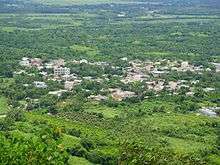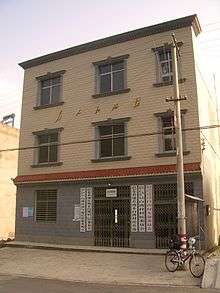Villages of the People's Republic of China
|
formally Village-level divisions | |||||||
| Chinese name | |||||||
|---|---|---|---|---|---|---|---|
| Simplified Chinese | 村级行政区 | ||||||
| Traditional Chinese | 村級行政區 | ||||||
| |||||||
| Alternative Chinese name | |||||||
| Chinese | 村 | ||||||
| |||||||
| Second alternative Chinese name | |||||||
| Chinese | 嘎查 | ||||||
| |||||||
| Mongolian name | |||||||
| Mongolian script | ᠭᠠᠴᠠᠭᠠ | ||||||
| |||||||
| This article is part of a series on |
| Administrative divisions of China |
|---|
|
Analogous county level units Management areas Management committee |
|
Townships
Subdistricts County-controlled districts (pilot) |
|
Analogous township level units Management areas Management committee Areas Farms area, Prison area, University towns etc. |
|
|
|
History: before 1912, 1912–49, 1949–present Administrative division codes |
Villages (Chinese: 村; pinyin: Cūn), formally village-level divisions (村级行政区; Cūn Jí Xíngzhèngqū) in China, serve as a fundamental organizational unit for its rural population (census, mail system). Basic local divisions like neighborhoods and communities are not informal like in the West, but have defined boundaries and designated heads (one per area). In 2000, China's densely populated villages (>100 persons/square km) had a population greater than 500 million and covered more than 2 million square kilometers, or more than 20% of China's total area.[1]
Types of villages
Urban
- Residential community (simplified Chinese: 社区; traditional Chinese: 社區; pinyin: shèqū)
- Residential committees (simplified Chinese: 居民委员会; traditional Chinese: 居民委員會; pinyin: jūmín wěiyuánhuì)
- Residential groups (simplified Chinese: 居民小组; traditional Chinese: 居民小組; pinyin: Jūmín xiǎozǔ
- Residential committees (simplified Chinese: 居民委员会; traditional Chinese: 居民委員會; pinyin: jūmín wěiyuánhuì)
- Note
- Urban village (Chinese: 城中村; pinyin: chéngzhōngcūn) one that spontaneously and naturally exists within urban area, which is not an administrative division.
Rural

A typical rural village in Hainan, China

The building housing the local village committee and other government offices and organizations in Baisha Village, Xiqiuwan Township, Badong County, Hubei
- Administrative village or Village (Chinese: 行政村 or 村; pinyin: xíngzhèngcūn or cūn)
- Gaqa (Chinese: 嘎查; pinyin: gāchá) only for Inner Mongolia.
- Ethnic village (Chinese: 民族村; pinyin: mínzúcūn) only for village populated by Ethnic minority.
- Village committees (simplified Chinese: 村民委员会; traditional Chinese: 村民委員會; pinyin: cūnmín wěiyuánhuì)
- Villager groups (simplified Chinese: 村民小组; traditional Chinese: 村民小組; pinyin: cūnmín xiǎozǔ)
- Village committees (simplified Chinese: 村民委员会; traditional Chinese: 村民委員會; pinyin: cūnmín wěiyuánhuì)
- Note
- Natural village (Chinese: 自然村; pinyin: zìráncūn) one that spontaneously and naturally exists within rural area, which is not an administrative division.
See also
References
- Bibliography
- Ellis, E.C. (2004). DeFries, R. S.; Asner, G. P.; Houghton, R. A., eds. "Ecosystems and Land Use Change" Long-term ecological changes in the densely populated rural landscapes of China (PDF). Geophysical Monographs. Washington, D.C.: American Geophysical Union. 153: 303–320.
- Joseph Esherick; Mary Backus Rankin; Joint Committee on Chinese Studies (U.S.) (1990). Chinese Local Elites and Patterns of Dominance. University of California Press. ISBN 978-0-520-06763-9.
- Roxann Prazniak (1 January 1999). Of Camel Kings and Other Things: Rural Rebels Against Modernity in Late Imperial China. Rowman & Littlefield. ISBN 978-0-8476-9007-7.
External links
- Chinese Village Government Information Network
- Two Chinese Villages, Two Views of Rural Poverty
- Long-term changes in China's village landscapes are changing the world
This article is issued from Wikipedia - version of the 9/25/2016. The text is available under the Creative Commons Attribution/Share Alike but additional terms may apply for the media files.